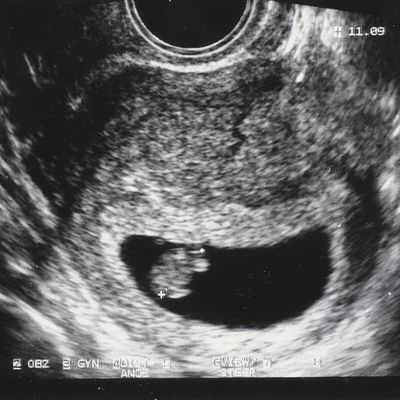
Within the last few years, six U.S. states — Kentucky, Mississippi, Ohio, Georgia, Iowa, and North Dakota — have passed so-called “heartbeat bills,” a term that’s become shorthand for a proposed ban on abortions beginning six weeks into a pregnancy, or the point at which a “fetal heartbeat” can be detected. Four more states have similar bills pending. Anti-abortion activists have doubled down on “heartbeat” messaging — in a recent news release regarding the ACLU’s legal challenge of the Ohio bill, the state’s leading anti-abortion group, Ohio Right to Life, used the term eight times in 300 words.
But obstetricians say the term “fetal heartbeat” is misleading, and that this scientific misunderstanding, among countless others, may contribute to negative public opinion toward abortion.
To wit: though pulsing cells can be detected in embryos as early as six weeks, this rhythm — detected by a doctor, via ultrasound — cannot be called a “heartbeat,” because embryos don’t have hearts. What is detectable at or around six weeks can more accurately be called “cardiac activity,” says Robyn Schickler, OB/GYN and fellow with Physicians for Reproductive Health. The difference between “cardiac activity” and “heartbeat” may seem linguistically minimal, but Schickler and others argue otherwise. At this stage, she says, what doctors can detect is essentially communication between a group of what will eventually become cardiac cells.
“From very early on, different cells are programmed to do different things for what is eventually a fully functioning human body,” says Jennifer Kerns, an OB/GYN and professor at the University of California in San Francisco. “These are cells that are programmed with electrical activity, which will eventually control the heart rate — they send a signal telling the heart to contract, once there is a heart.” It is this early activity which ultrasounds detect — not a heartbeat.
In a doctor/patient setting, though, says Shickler, physicians have used the term “heartbeat” or “fetal heartbeat” to convey to patients with wanted pregnancies that fetal development is proceeding as it should. “If I have a patient in front of me who is excited about her pregnancy, and hoping for signs that it’s currently developing properly, that little flicker can tell us that, at that point in the pregnancy, things look good,” says Sarah Horvath, a family planning fellow at The American College of Obstetricians and Gynecologists. That things “look good” is not equivalent to declaring a fetus viable, and patients can and do experience miscarriage, stillbirth, or other developmental problems after seeing that flicker on an ultrasound. To someone who wants to be pregnant, it’s merely a good sign.
Part of the effort behind popularizing “heartbeat bill” as a term is the conservative effort to propose a new, much earlier standard of viability, the term used to describe the point at which a fetus has a good chance of survival outside the womb with access to maximum medical intervention, says Kerns. It simply isn’t true that a six-week embryo is viable. While there is no unanimous timeline assigned to viability, most doctors use 24 weeks as a general rule.
But what arose as a colloquialism between doctors and patients has, in the case of the fight over abortion rights, done more harm than good, says Schickler. At six weeks, she says, a pregnant person has likely just missed their period two weeks earlier, and at that stage, the fetus is far from viable — so calling any activity detected by ultrasound at that stage a heartbeat “personifies the fetus into something it’s not,” says Schickler. Which, says Kerns, is exactly the point.
“It’s a deliberate use of a word that evokes a very emotional response, and conjures up the idea of an actual heart as we know it,” says Kerns. At six weeks, she says the embryo is about seven millimeters long, such that the flicker made visible by ultrasound technology is about the size of a pencil tip, she adds. “Heartbeat” conjures an organ which expands and contracts, but a six-week embryo has yet to develop that structure, says Horvath.
“The characteristic ‘lub-dub’ of the heart is created by the valves in a four-chambered heart opening and closing,” says Horvath. Even when that structure does develop, it’s not like it works on its own. “In order for a fully formed heart to function properly, it has to communicate with other systems of the body,” says Kerns. “It has to communicate with the neurologic system, so the brain has to be developed enough to send signals to the heart to speed up, slow down, to function.” For that reason (among others), it’s inaccurate and unscientific to define viability by the mere existence of any one organ.
By calling anti-abortion legislation “heartbeat bills,” or insisting that an embryo has a heart that beats at 18 days, anti-abortion activists are vastly, and dangerously, over-simplifying fetal development for political gain. And according to some polls (which, notably, often adhere to anti-abortion activists’ framing), it’s working.





